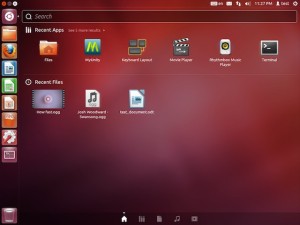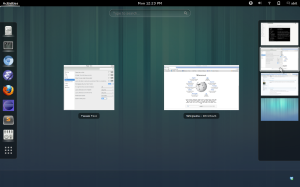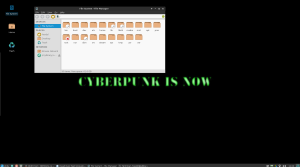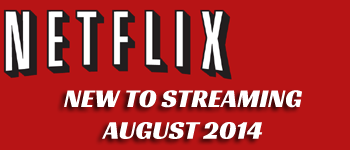Linux: Desktop Environments
At the moment I’m reading a Book called “In the Beginning… Was the Command Line” It’s a very interesting read that has made me think about the computer ‘desktop’ and the choices I make regarding it. I am aware of how Geeky this is.
The thing that struck me about all this is that its not the first time I have thought about the desktop as a choice. Being a long time Linux hobbyist even before I made the switch full time I have encountered many desktop interfaces over the years and had to make a selection about which to use long term.
For Windows and Mac users the concept of choosing a desktop environment is an alien idea. Many people probably haven’t even consciously thought about it as a choice. Let me explain; A desktop is the interface, the bits of the computer that you ‘see’ the bits that aren’t a program you have loaded. So, when you turn on your Windows PC, that bar at the bottom, those icons on desktop. That’s your desktop environment, those decorations and bars around the windows and programs you open, all part of it.
Microsoft aficionados would tell you that its more than a design choice and windows IS it’s desktop interface but as anyone who had ever installed a custom theme or custom Start Menu onto Windows knows, that’s something of a stretch.
In Linux the choice is not hidden or managed, when you log into your system you get whatever is set as the default but with a little click (on lots of Log-in managers its a little cog) you can select from any of the desktop’s you have installed. Now, its important to remember, this is still the same computer, all your programs are there, all your files are where you left them and all your options are as you set them. You are just selecting another way to interact with the computer.
There are a wide range of desktop environments available on Linux from traditional (applications menu in bottom left, bar across bottom) to almost invisible ones (Tiling window managers) and then there are things that appear to be madness at fist but all have their place in the world and all have their audiences.
One of the most popular Linux Distributions ‘Ubuntu’ took the matter so seriously that they created their own Desktop interface entirely, its called Unity and to be honest, its not bad but it is very integrated with their OS and although works on some other Distro’s its a pretty forgone conclusion that if you see it on someones computer they are probably running Ubuntu. It consists of a full height ‘dock’ type menu on the left of the screen and a bar across the top that will show you information as you need it, including the applications menu items and the time & date.
 My usual Desktop is Gnome (Gnome3, Gnome shell) its a very different experience from what most people are accustomed to and sits somewhere between a traditional desktop and a Tablet UI. All the applications are found in one alphabetically organized menu and there are no icons on desktop. When I press the windows (super) key there is no start menu instead I get a zoomed out overview of all my running applications, I click on one to select it. I like Gnome very much. It feels like a step in the direction that I want computing to move.
My usual Desktop is Gnome (Gnome3, Gnome shell) its a very different experience from what most people are accustomed to and sits somewhere between a traditional desktop and a Tablet UI. All the applications are found in one alphabetically organized menu and there are no icons on desktop. When I press the windows (super) key there is no start menu instead I get a zoomed out overview of all my running applications, I click on one to select it. I like Gnome very much. It feels like a step in the direction that I want computing to move.
 As I write this post I am in a desktop environment called XFCE (version 4) it’s a desktop that has a bar, at the top by default and a little launcher panel, usually at the bottom. I customized mine. There is a bar at the bottom and the little launcher auto-hides to the left of my screen only being visible when I move my mouse towards it.
As I write this post I am in a desktop environment called XFCE (version 4) it’s a desktop that has a bar, at the top by default and a little launcher panel, usually at the bottom. I customized mine. There is a bar at the bottom and the little launcher auto-hides to the left of my screen only being visible when I move my mouse towards it.
I am only ‘in’ XFCE because this morning I was installing some new icon packs and I wanted to see how they looked, then, as all my files, settings and programs are persistent and only the interface had changed I just sort of forgot to log out and go back into Gnome.
 The fact that I keep both installed at all time (as a minimum) is in case something goes wrong with an update for one. For instance, if I install some ‘extensions’ (little customization and tiny applications) in Gnome that go a bit wonky when I update to a new version then its nice to know XFCE will always be there for me. I can use it to fix the configuration files for Gnome and be in an environment i like while I’m doing it. Sure the Command Line Interface is great but a GUI is nice.
The fact that I keep both installed at all time (as a minimum) is in case something goes wrong with an update for one. For instance, if I install some ‘extensions’ (little customization and tiny applications) in Gnome that go a bit wonky when I update to a new version then its nice to know XFCE will always be there for me. I can use it to fix the configuration files for Gnome and be in an environment i like while I’m doing it. Sure the Command Line Interface is great but a GUI is nice.
People may sight this an expectation of failure in my OS an yes, it is. If I were running a stable, reliable version of Linux like Ubuntu or Mint then redundancy would be less important as things probably won’t break but as I run Arch, a Distro that is updated with the newest packages as soon as they become available. Stuff breaks for me from time to time. If you talk to any serious Linux user they will have a favourite Desktop, regardless of the distribution they use they will often install a new desktop environment even though theres nothing wrong with the ‘standard’ that the Distro offers. most keep many installed, its so easy to switch you find yourself ‘exploring’ the delights on offer. and some times you just fancy a change.
If you have choice you will often exorcise it. It’s one of the many things I love about my OS of choice an one of the MANY reasons that I have left windows behind.






















FUNNY ARTICLES NERDY VIDEOS